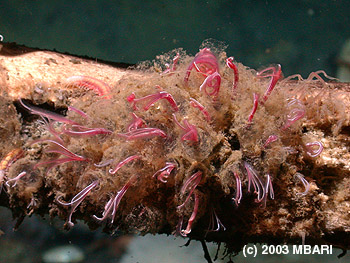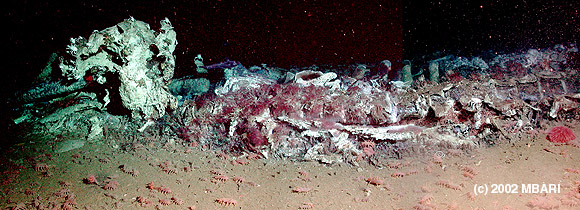Critter of the month - Osedax: The zombie worm
Interview with
Deep sea biologist Greg Rouse picks the bone eating worm as our Critter of the Month.
Greg - I'm Greg Rouse. I'm a professor here at the Scripps Institution of Oceanography. And if I had to be a critter I would choose Osedax, which are bone eating worms.
 These amazing animals live in the deep sea mainly. And what they're doing is as little baby larvae they are swimming around in the plankton.
These amazing animals live in the deep sea mainly. And what they're doing is as little baby larvae they are swimming around in the plankton.
They're waiting for occasional bones of a dead whale falling to the bottom. They then land on these bones and of course most of them never have a chance to land on a bone because they die.
But those that do, land on the bones and they grow up by co-opting bacteria to live in their tissues and working together with the bacteria they dissolve the bone and eat the fats and collagen in the bone.
What's amazing about them is that the ones that initially settle are all females. So it's females that dissolve and eat the bone.
And then once they've covered the bone, any new babies coming in are taken by the females and made into little dwarf males. So the females actually accumulate harems of dwarf males.
 So far we've found 17 species of these amazing animals. And they were only discovered in 2002. And we think there are probably many more species of these all over the oceans of the world, waiting for bones to fall to the bottom.
So far we've found 17 species of these amazing animals. And they were only discovered in 2002. And we think there are probably many more species of these all over the oceans of the world, waiting for bones to fall to the bottom.
The other thing we've been studying is when they might have evolved, because whales have only been around for about 50 million years. And some of the recent work we've done has shown that in fact they'll eat fish bones and other mammals bones.
We're starting to think that they might have been around in the Cretaceous, back more than 65 millions years ago when they could have been eating vast bone resource such as plesiosaurs and mosasaurs. So they might actually be a very ancient group of worms.
Their closest relatives are actually hydrothermal vent worms that are gigantic animals called
Riftia. And all this groups actually, we've now discovered are not anything more than derived relatives of things that we're familiar with such as earth worms and other things called annelids.
So the amazing worm Osedax is really just a very very bizarre relative of earth worms.
Find out more
Greg Rouse's lab at Scripps
Vrijenhoek, Johnson and Rouse (2009). A remarkable diversity of bone-eating worms, (
Open access paper)










Comments
Add a comment